Preparing for a hair follicle screening can feel overwhelming. If you’re looking for information, I’ve gathered details on some shampoos discussed online for those facing a hair follicle test. It’s important to understand that while some products claim effectiveness, reducing detectable substances in hair is complex and no method guarantees a negative result.
Many people seek solutions that don’t involve extreme measures like bleaching, shaving, or causing significant damage to their hair and scalp. The goal is often to find approaches perceived as gentler yet potentially helpful in cleansing hair, without needing complex routines or excessive costs. Facing a hair screening can be stressful, especially when job opportunities are on the line.
Let’s explore the topic in more detail.
Understanding Hair Follicle Screenings
Before diving into shampoos, it helps to understand why hair tests are used and how they work. Employers sometimes prefer hair tests because they offer a longer detection window compared to urine tests, typically looking back about 90 days, depending on the length of the hair sample (based on average hair growth of 0.5 inches per month). This provides a broader history of potential substance exposure.
How Toxins Get Into Hair and How Detox Shampoos Claim to Work
When someone consumes toxins, metabolites circulate in the bloodstream. These metabolites become incorporated into the hair follicle and are embedded within the hair shaft as it grows. Sebum, the natural oil produced by glands in the scalp, can also contain toxins that coat the hair strand.
Hair detox shampoos are formulated with the intention of penetrating the hair shaft to remove these metabolites. Hair has three main layers: the cuticle (outer protective layer), the cortex (middle layer containing pigment and structure, where most metabolites are trapped), and sometimes the medulla (innermost core). These shampoos often contain strong cleansing agents designed to temporarily open the cuticle scales, allowing access to the cortex to wash away the embedded traces. Many also include conditioning ingredients to help reseal the cuticle afterwards, aiming to leave hair feeling smoother.
Do Detox Shampoos Actually Help Reduce Metabolites? A Look at Some Studies
The effectiveness of detox shampoos in significantly reducing toxin concentrations is a subject of debate and research. Some studies have explored whether certain treatments can lower these levels in hair.
It’s crucial to approach these studies with caution. They often occur under specific laboratory conditions that might not perfectly replicate real-world scenarios. Remember, a reduction in drug metabolites doesn’t automatically mean falling below the test cutoff levels, as labs have specific thresholds.
Let’s simplify the findings of one study mentioned. Think of your hair as a timeline of substances in your body. This study investigated whether certain products could help obscure parts of that timeline. Researchers treated hair samples containing toxins (like marijuana, cocaine, morphine) with various substances, including vodka, regular hair tonic, a specific detox shampoo, disinfectant, and even Head and Shoulders.
The findings indicated these treatments could reduce toxin traces, with reductions reportedly ranging from about 52% to 65% under the study’s conditions. The specialized detox shampoo was noted as one of the more effective options tested. Interestingly, the study also mentioned that visual inspection couldn’t easily determine if the hair had been treated.
So, while this suggests some effect on metabolite levels, it’s far from a guarantee of achieving a negative test result.
Another Study Brief
A different study specifically tested a product called Ultra Clean shampoo on hair from 14 users. Hair was washed once with the shampoo and analyzed.
The results showed a decrease in toxin levels after this single wash under lab conditions:
- cocaine by an average of 5%,
- morphine by an average of 26%,
- and THC by an average of 36%.
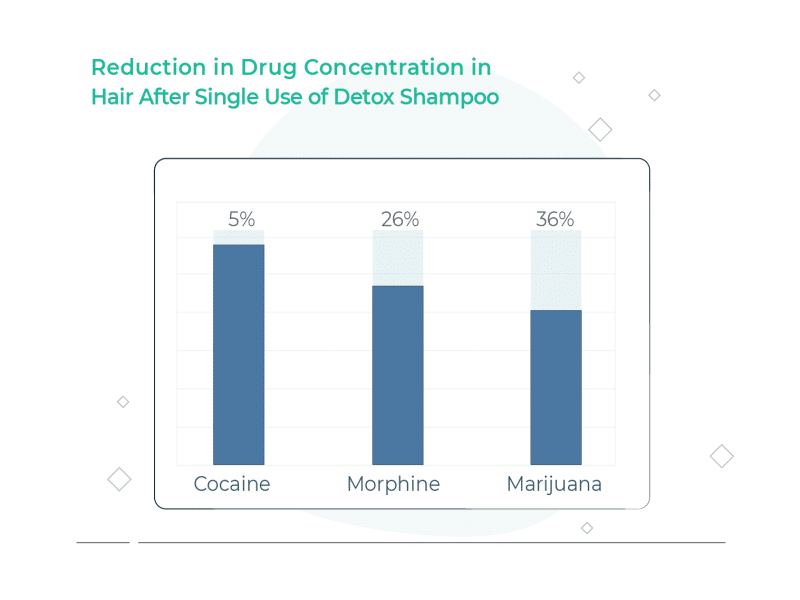
This study suggests the shampoo can reduce toxin concentrations, but again, the percentage reduction might not be enough to fall below testing cutoffs, especially for heavy users, and this was after only one wash.
Drug Test Detox Shampoos and ETG (Alcohol Metabolite)
Alcohol consumption can also be detected in hair, typically by looking for Ethyl Glucuronide (EtG). One study examined if detox shampoos could mask EtG.
Researchers tested four detox shampoos on hair samples. For EtG, three shampoos performed similarly to plain water. However, one specific shampoo reportedly showed a significant reduction in EtG levels – up to 86% after 2.5 hours of soaking in the study conditions. Further tests confirmed its potential to lower EtG.
Important Caveat: These studies provide data points, but they don’t guarantee real-world success in achieving a negative result. Factors like individual metabolism, drug usage frequency and amount, hair type, and the specific lab’s testing sensitivity all play a significant role.
Choosing a Shampoo Discussed for Hair Screening Preparation
When exploring detox shampoos online, it’s wise to look past marketing claims and try to find information based on user reports and available research, however limited. Here’s what people often consider:
Suitability of the Product
The market has many “detox” shampoos, but most are for removing environmental pollutants or product buildup. For hair screening preparation purposes, people seek shampoos specifically claiming to target metabolites within the hair shaft. I’ve focused on shampoos frequently discussed in forums and articles related to preparing for these tests.
Safety Concerns
Safety should always be a priority. Some aggressive methods, especially DIY approaches involving harsh chemicals like bleach or certain detergents (discussed later), carry significant risks of hair damage, scalp burns, and irritation. Users have reported severe consequences, sometimes leading to hair loss or needing to cut their hair. Visibly damaged hair or scalp could also alert a test collector. The shampoos primarily discussed here are generally considered less harsh than extreme DIY methods, but always check ingredients and follow instructions carefully.
Bottle Size and Usage Frequency
The amount of shampoo needed is a practical consideration. Many online sources suggest repeated washings are necessary, especially for individuals with a history of heavier substance use. A common recommendation found online is washing 15 or more times leading up to a test. Since verifying hair cleanliness at home is difficult (unlike urine tests), some people prefer to err on the side of caution with more washes. A typical wash might use around 10ml, so a 150ml bottle might provide roughly 15 washes. Those with long hair or dreadlocks might need substantially more. Ensure the product size aligns with the usage frequency you anticipate.
Brand Reputation and User Feedback
Reviews can be tricky. Look for feedback specifically related to hair cleansing for screenings, not just general hair appearance. Be aware that reviews can be biased or anecdotal. I’ve tried to consider products that have generated significant discussion and user reports regarding test preparation.
Top Detox Shampoos Often Discussed for Hair Screening Preparation
Finding reliable information in this area is challenging. The market for products claiming to help reduce detectable metabolites operates in a gray area, both morally and legally for sellers.
This can lead to some companies marketing regular clarifying shampoos with detox-sounding names, potentially misleading consumers. Dissatisfied customers are often hesitant to pursue complaints after receiving an unwanted test result.
In this overview, I’m focusing on two products that are frequently mentioned and have garnered a reputation, based on anecdotal reports and the limited studies available, for potentially aiding in the reduction of metabolites.
Aloe Toxin Rid Shampoo: A Frequently Cited Detox Option

Aloe Toxin Rid is often discussed as a primary option for those looking to reduce contaminants, including drug toxins, in their hair. It’s frequently mentioned as a choice, particularly for individuals with higher levels of exposure, like regular marijuana users. Some combine it with Zydot Ultra Clean (discussed next) for a multi-step approach aimed at thorough cleansing.
Its formulation includes aloe vera and is generally considered gentler on hair and scalp compared to harsh chemical methods. It aims to remove substances like THC and cocaine metabolites while using conditioners to maintain hair health.
The price point (around $200-$235) is significant, reflecting its niche market and the ingredients involved. Users often report using it daily for 3-10 days before a test, aiming for at least 15 washes. The suggested routine is typically:
- Wash with your regular shampoo first, rinse.
- Apply Aloe Toxin Rid, lather, and let it sit for 10-15 minutes, rinse.
- Follow with your regular conditioner.
Summary (Based on Manufacturer/Retailer Info & User Reports)
- Reportedly Used For: Individuals with moderate to heavy exposure, various hair types including black hair, afro hair, dreadlocks. Aimed at reducing metabolite levels.
- Common Usage Pattern: 10-15 washes over several days leading up to a screening.
- Approximate Uses Per Bottle (5oz/150ml): Around 15-23 (depending on hair length/thickness).
- Claimed Effect Duration: The removal is permanent on treated hair, but new hair growth can contain metabolites. Effects are most relevant close to the test date. Typically recommended to use up to the day of the screening.
- Price: Around $200 (or $235 bundled with Zydot Ultra Clean).
- Price per oz: Approx $40 (based on 5oz bottle at $200).
Zydot Ultra Clean: A Multi-Component System Often Used Closer to Test Day
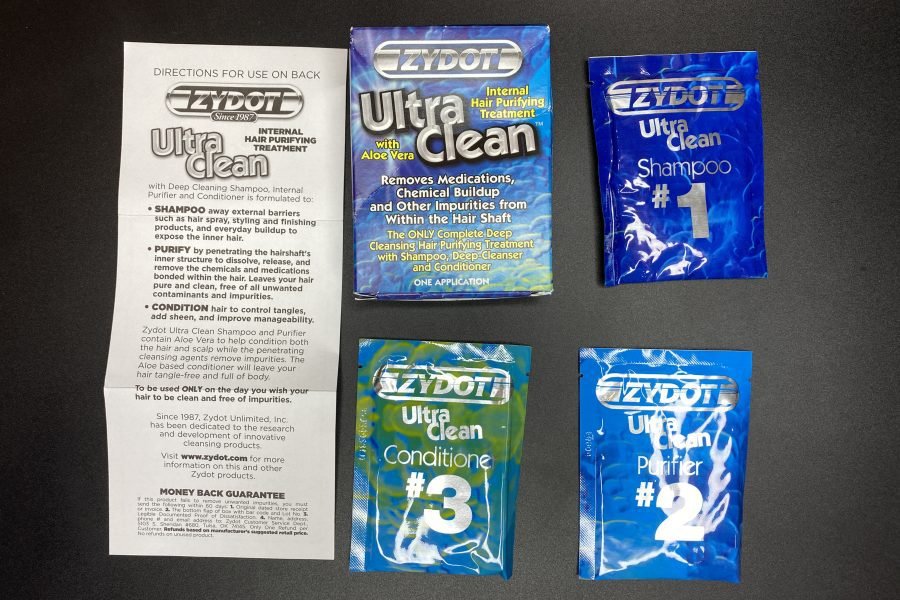
Zydot Ultra Clean is another well-known name in hair detox discussions. It’s a three-part system: shampoo, purifier, and conditioner. It’s notably mentioned as part of the “Jerry G Method” (a harsh DIY approach discussed later) but is also used on its own, particularly by those reporting lighter substance use or as a final cleansing step after using Aloe Toxin Rid.
The components are designed to work sequentially:
- Shampoo: Cleanses external barriers like styling products and dirt.
- Purifier: Aims to penetrate the hair shaft to dissolve and release internal metabolites.
- Conditioner: Intended to improve hair condition and manageability after the treatment.
Zydot Ultra Clean is often suggested for those seeking to address lower levels of exposure. For heavier use history, it’s frequently recommended online to be used in combination with a primary detox shampoo like Old Style Aloe Toxin Rid for a more thorough cleansing attempt.
Summary (Based on Manufacturer/Retailer Info & User Reports)
- Reportedly Used For: Individuals with light exposure, or as a final step for heavier users (often combined with Aloe Toxin Rid). Suitable for various hair types. Intended to reduce metabolites.
- Common Usage Pattern: One full application, typically on the day of the screening.
- Approximate Uses Per Box: One complete treatment.
- Claimed Effect Duration: Primarily effective for a limited window (often cited as up to 24-36 hours) before new oils (sebum) potentially re-contaminate the hair surface.
- Price: Around $36.
- Price per oz: Price is per kit, not per oz.
Pros Often Mentioned
- Relatively inexpensive compared to Aloe Toxin Rid.
- Provides a complete kit (shampoo, purifier, conditioner).
- Contains aloe vera for conditioning.
Cons Often Mentioned
- May not be sufficient on its own for those with heavy substance use history.
- Effectiveness window is considered limited due to potential re-contamination from natural hair oils.
How Zydot Ultra Clean is Typically Used (Manufacturer Instructions):
- Wet hair thoroughly. Wash with your regular shampoo first if desired, rinse well.
- Apply half of the Zydot Shampoo (Packet #1). Massage into scalp and hair for 10 minutes. Rinse well.
- Apply the entire contents of the Purifier (Packet #2). Massage thoroughly into scalp and hair, especially near the scalp. Comb through. Leave on for 10 minutes. Rinse well.
- Apply the remaining Zydot Shampoo (Packet #1). Massage into scalp and hair for 10 minutes. Rinse well.
- Apply the entire contents of the Conditioner (Packet #3). Distribute evenly, massage into scalp and hair. Leave on for 3 minutes. Rinse thoroughly.
Additional tips often suggested alongside Zydot usage:
- Abstain from substances for at least 24-48 hours before use, and ideally much longer.
- Use the product on the day of the test due to the limited effectiveness window.
- Heavy users, or those with long/thick hair, might consider multiple applications or using it after a course of Aloe Toxin Rid.
- Avoid re-contamination: Use clean towels, combs/brushes, pillowcases, and avoid hats or hoodies worn previously.
While other shampoos claim effectiveness, I’ll mention a few more often seen online, but proceed with extra caution as their efficacy is less substantiated and reviews are often mixed or poor.
Other Options Often Discussed (Use with Caution)
Stinger Folli-Kleen Intense Hair Cleanser: A Lower-Cost Option with Mixed Feedback
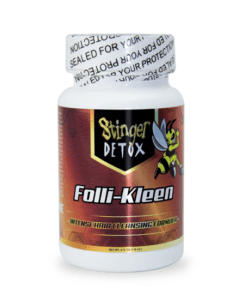
From years of looking into haircare products, you learn to spot different tiers of offerings. Stinger Folli-Kleen falls into a category where affordability is a main selling point.
At around $30-$35, it’s less expensive than the leading options. It’s marketed as FDA registered and made in the USA, using naturally derived ingredients, which might appeal to some.
However, user reviews specifically regarding achieving negative screening results are quite mixed. This suggests its reliability might be questionable, potentially only offering a possibility for those with very minimal exposure levels willing to accept a higher risk of an unwanted result.
Summary (Based on Manufacturer/Retailer Info & User Reports)
- Reportedly Used For: Possibly minimal/one-time users attempting to reduce metabolites.
- Common Usage Pattern: Typically used once before a test.
- Approximate Uses Per Bottle (4oz): Depends on hair length, potentially 4-5 washes.
- Claimed Effect Duration: Limited window, similar to Zydot.
- Price: Around $34 (sometimes found cheaper on platforms like Amazon).
- Price per oz: Approx $8.50.
High Voltage Detox Shampoo: The Cheapest Option with Significant Doubts

High Voltage Detox Shampoo stands out primarily for its very low price, often available for under $15. As is often the case, this low cost might correlate with performance.
User reviews related to achieving desired test outcomes are generally poor. While it might theoretically offer some cleansing, its ability to effectively remove embedded drug metabolites is highly questionable based on user feedback. It’s generally considered a high-risk option, perhaps only contemplated by someone with extremely light, single-instance exposure hoping for some reduction.
Summary (Based on Manufacturer/Retailer Info & User Reports)
- Reportedly Used For: Possibly minimal/one-time users (High Risk of not being effective enough).
- Common Usage Pattern: Used once before a test.
- Approximate Uses per bottle (2oz): Small bottle, maybe 1-2 uses for short hair.
- Claimed Effect Duration: Limited window.
- Price: Around $12-$17.
- Price per oz: Approx $6-$8.50.
Macujo Aloe Rid Old Formula Shampoo (Different from ‘Old Style Aloe Toxin Rid’)
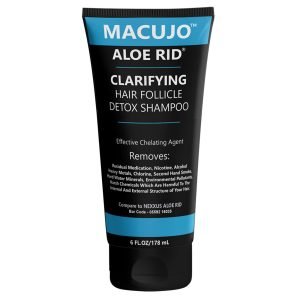
This shampoo positions itself as similar to the original Nexxus Aloe Rid formula (which the ‘Old Style Aloe Toxin Rid’ also claims lineage from). It’s often marketed specifically for use with the “Macujo Method” (a harsh DIY process involving vinegar, astringent, and laundry detergent – discussed later).
Reviews are varied. Some moderate users report achieving their desired results, while others do not. The recommendation to use it with the damaging Macujo Method is a major red flag regarding safety.
Furthermore, the suggested usage frequency (up to 20 washes) often means needing more than one bottle (typically providing around 17 uses), potentially making it as expensive or more expensive than Old Style Aloe Toxin Rid, while being associated with a much harsher overall process.
Summary (Based on Manufacturer/Retailer Info & User Reports)
- Reportedly Used For: Moderate users attempting metabolite reduction, often in conjunction with the harsh Macujo Method.
- Common Usage Pattern: Up to 20 washes suggested.
- Approximate Uses Per Bottle (6oz): Around 17.
- Claimed Effect Duration: Removal is permanent on treated hair, but needs application close to test day.
- Price: Around $170.
- Price per oz: Approx $28.
A General Approach to Using Detox Shampoos (Based on Common Recommendations)
Here’s a generalized guide based on how products like Aloe Toxin Rid and Zydot Ultra Clean are often used together for hair cleansing preparation. Remember, following these steps does not guarantee a negative test result.
- If you have very light, infrequent exposure, some sources suggest Zydot Ultra Clean alone on test day might offer some cleansing effect (high uncertainty).
- For moderate to heavy exposure history, the commonly discussed approach involves using a primary detox shampoo like Aloe Toxin Rid first for a more intensive cleansing regimen.
- Start using the primary shampoo (e.g., Aloe Toxin Rid) daily, ideally beginning 3-10 days before the test.
- If time is short, some people shower multiple times a day, but be mindful of potential scalp irritation.
- During each wash with the primary shampoo, lather and leave it in your hair for 10 to 15 minutes to allow time for penetration, according to typical advice.
- Aim for at least 15 washes with the primary shampoo before the test day, according to common advice for thorough cleansing.
Routine Using Primary Shampoo (e.g., Aloe Toxin Rid):
- Start with Regular Shampoo (Optional but Recommended): Wash with your normal shampoo to remove surface oils and styling products.
- Rinse Thoroughly: Make sure all regular shampoo is out.
- Apply Primary Detox Shampoo (e.g., Old Style Aloe Toxin Rid): Use about a quarter-sized amount (adjust for hair length). Massage thoroughly into scalp and hair.
- Let it Soak: Leave lathered in your hair for 10-15 minutes.
- Rinse Out: Wash the detox shampoo out completely.
- Condition Regularly: Finish with your normal conditioner. Focus on conditioning, as the detox shampoo can be drying.
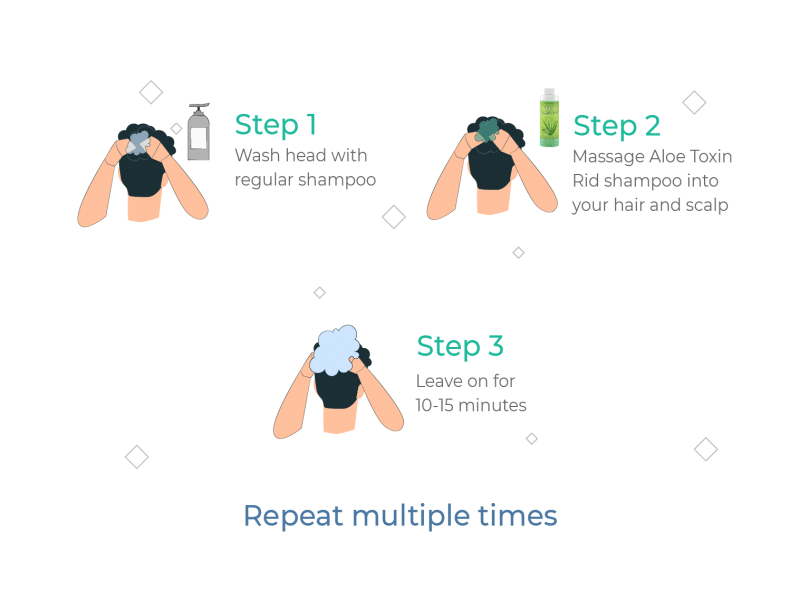
On the Day of the Test: Using Zydot Ultra Clean (as a Final Step)
Follow the Zydot package instructions carefully (summarized earlier):
- Wash with half the Zydot shampoo (Packet #1) for 10 mins, rinse.
- Apply all the Purifier (Packet #2) for 10 mins, rinse.
- Wash with the remaining Zydot shampoo (Packet #1) for 10 mins, rinse.
- Apply all the Conditioner (Packet #3) for 3 mins, rinse.
After completing the final rinse, style your hair as usual using only clean tools and avoiding potentially contaminated accessories.
A Word of Caution on DIY Methods (Jerry G, Macujo) – STRONGLY DISCOURAGED
Before even considering homemade “remedies” like the Jerry G or Macujo methods, it’s crucial to understand the significant and severe risks involved. These methods often involve extremely harsh chemicals and household products not meant for hair that can cause serious damage to your hair and scalp.
The potential for painful chemical burns, severe irritation, lasting scalp problems, significant hair breakage, and even permanent hair loss is very real. For many people, the resulting hair damage can be deeply distressing and irreversible. Here’s what some individuals have shared online about their experiences with such methods:
- “Wouldn’t wish that process on my worst enemy.”
- “The relaxer really irritates your scalp after the Macujo.”
- “Bleach makes scalp burn like hell apparently and causes hair/scalp damage.”
- “Crazy scalp melting treatments.”
- “So when I damaged my hair, I felt like my life was RUINED.”
- “After my test, I decided to cut my hair because I wasn’t trying to look like Patchy the Pirate, so I got a bald fade.”
- “I had dandruff and pieces of my scalp were falling out for like a week and a half after.”
Furthermore, test collectors are often trained to look for signs of hair tampering. Obvious damage from bleaching or harsh chemicals might raise suspicion, potentially leading them to collect body hair instead (which can have longer detection windows), rendering your efforts useless and possibly leading to further scrutiny or negative consequences.
Given these severe risks to your health and appearance, and the lack of scientific validation for their effectiveness, pursuing these DIY methods is strongly discouraged. Safer, commercially available detox shampoos, while still not guaranteed to produce a desired result, are formulated specifically for hair and are designed to minimize harm compared to these dangerous practices.
The Jerry G Method (General Description – High Risk, Not Recommended)
This method, discussed online, is known for being extremely aggressive. It generally involves repeatedly dyeing the hair with harsh, ammonia-based dyes, often combined with baking soda pastes and washes using specific detox shampoos over a period of days. The theory is that the harsh chemicals open the hair cuticle aggressively. However, this process can lead to severe scalp burns, intense irritation, and significant hair damage or breakage.
The Macujo Method (General Description – High Risk, Not Recommended)
Another aggressive, multi-step process frequently discussed online, the Macujo method is infamous for using a combination of harsh substances. It typically involves soaking the hair in high-acidity vinegar, followed by applying salicylic acid astringents, washing with specific detox shampoos, and controversially, scrubbing the hair and scalp with liquid laundry detergent. This combination is extremely harsh and damaging, commonly causing severe scalp irritation, chemical burns, hair thinning, and breakage. The use of laundry detergent on hair and skin is particularly dangerous and strongly advised against.
Again, due to the high potential for serious harm and unproven effectiveness, both the Jerry G and Macujo methods are strongly discouraged.
Tips for Hair Cleansing Preparation When Facing a Hair Screening
While no method is foolproof besides abstinence, here are some commonly suggested tips for individuals preparing for a hair test:
- Stop All Substance Use Immediately: The longer the period of abstinence before the test, the less recent exposure will be recorded in the newest hair growth. Ideally, stop use weeks or months in advance, but even stopping 5-10 days before starting any cleansing process is crucial to prevent new metabolites from entering the hair being treated.
- Avoid Re-contamination: After starting any cleansing process, use clean towels, combs, brushes, and pillowcases. Avoid wearing hats, headbands, hoodies, or anything else that has contacted your hair previously and might hold residues. Be mindful of headrests in cars or on furniture.
- Time Management is Key: Hair grows roughly half an inch per month. Labs typically test the 1.5 inches closest to the scalp, representing about 90 days. Start any cleansing regimen as soon as you know about the test, allowing maximum time for washing the relevant hair segment.
- Understand the Consequences: Be aware of your employer’s or the testing entity’s policy regarding drug tests, including the consequences of a positive result or suspected tampering. Attempting to alter a test can have serious repercussions beyond just the initial result.
- Abstinence is the Only Guarantee: It bears repeating – the only way to be 100% certain of a negative drug test result is not to have used the substances being tested for within the detection window.
Hair Screening Procedure: What to Expect
Knowing the typical collection process can help reduce anxiety:
- Location: The collection might happen at a dedicated lab, a clinic, a hospital, or sometimes even at your workplace, with the sample then sent to a lab.
- Identification Check: You’ll likely need to show a valid photo ID.
- Explanation: The collector should explain the procedure before they begin.
- Sample Collection: The collector, wearing gloves, will typically cut a small sample of hair (about 100-120 strands, the thickness of a pencil lead) from the back of your head, near the crown, as close to the scalp as possible. They use sanitized scissors. Usually, about 1.5 inches length is needed for the standard 90-day history test. If scalp hair is too short or unavailable, body hair might be collected (detection windows for body hair can be longer).
- Packaging: The collected hair is placed in a foil packet and then into a sealed collection envelope, often initialed by you, to maintain the chain of custody.
- Lab Analysis: The sealed sample is sent to an accredited laboratory for testing.
- Results: Results are typically reported back to the requesting entity (e.g., employer) within a few business days (often 3-5, but can vary).
How Long Can Drugs Be Detected in Hair?
Technically, once drug metabolites are incorporated into the hair shaft, they remain there permanently until that portion of the hair is cut off or physically/chemically removed. The standard 1.5-inch sample looks back approximately 90 days. Longer hair could potentially show use from further back if specifically tested in segments, but this is uncommon for standard employment screening.
Even after stopping use, metabolites can continue to enter new hair growth for as long as they remain in your bloodstream (which varies by drug – e.g., THC can linger for weeks in heavy users).
Why Choose Detox Shampoos Over Harsher DIY Methods?
As highlighted earlier, methods like Macujo and Jerry G involve significant risks due to harsh chemicals like bleach, ammonia, vinegar, and even laundry detergent.
The potential for severe scalp burns, irritation, lasting dandruff, hair breakage, and the distress caused by this damage is substantial. Furthermore, experienced collectors may recognize the signs of chemical damage, leading to suspicion and potentially the collection of body hair, negating the effort and potentially causing further issues.
Specially formulated detox shampoos like Old Style Aloe Toxin Rid and Zydot Ultra Clean, while still requiring careful use and not offering guarantees about test results, are designed specifically for hair and aim to cleanse without causing the extreme, visible damage associated with harsh DIY concoctions. They represent a potentially safer (though still uncertain) approach for individuals seeking ways to address a hair screening.
FAQ
Can shampoos help reduce metabolites for a hair follicle screening?
Standard shampoos do not remove internal metabolites. Specialized detox shampoos claim to work by opening the hair cuticle and washing out metabolites. Some limited studies show they can reduce drug concentrations, but effectiveness varies greatly, and they do not guarantee falling below test cutoffs. Success depends on many factors including the specific product, usage frequency, drug habits, and individual hair characteristics.
How long does any cleansing effect from detox shampoo last?
Any cleansing effect on the treated portion of the hair is considered permanent for that specific hair section. However, as your hair continues to grow, any drug metabolites still present in your system can be deposited into the new hair growth near the scalp. This is why detox shampoos are typically recommended for use right up until the day of the test.
Is Selsun Blue effective for reducing hair metabolites?
There is no credible evidence to suggest that Selsun Blue or other dandruff shampoos are effective at removing drug metabolites from within the hair shaft for the purpose of altering a drug test result. Relying on such methods is highly risky and unlikely to be effective.
Can Zydot or other detox shampoos be detected in a hair test?
Standard hair drug tests screen for drug metabolites, not for the ingredients commonly found in detox shampoos like Zydot Ultra Clean or Aloe Toxin Rid. Therefore, the use of these shampoos themselves is generally considered undetectable by the test. However, methods causing visible damage (like aggressive bleaching or chemical treatments) can be detected visually by the collector.
Will bleaching your hair affect a hair screening?
Bleaching can damage the hair cuticle and potentially reduce drug metabolite concentrations to some extent. However, it also causes significant, often obvious, damage to the hair and scalp. This visible damage can alert the test collector, who might become suspicious and choose to collect body hair instead. Bleaching is a harsh, risky approach with unpredictable results regarding metabolite reduction.
Are there home methods like bleaching that can affect a hair follicle test?
Yes, home methods involving bleaching, dyeing (with ammonia), vinegar, etc., (like the Jerry G or Macujo methods described generally above) exist and are discussed online. These aim to chemically alter or strip the hair. However, they carry a very high risk of severe hair and scalp damage, are not scientifically proven to guarantee a negative result, and the damage itself can raise red flags during collection, potentially leading to unwanted consequences. These methods are h3ly discouraged due to safety concerns.
What drugs can be detected?
Standard hair tests often screen for a panel of drugs, commonly including:
- Amphetamines (including methamphetamine, MDMA/ecstasy)
- Marijuana metabolites (THC-COOH)
- Cocaine and its metabolites (e.g., benzoylecgonine)
- Opiates (e.g., codeine, morphine, heroin metabolite 6-AM)
- Synthetic Opioids (e.g., oxycodone, hydrocodone, hydromorphone, oxymorphone)
- Phencyclidine (PCP)
Testing panels can vary.
Can a lab determine when the drugs were taken?
A standard hair test using a 1.5-inch sample generally indicates use within the past 90 days but doesn’t pinpoint exact dates. The entire sample is typically tested together. Segmental analysis (testing the hair in sections, e.g., month by month) is possible and can provide a more specific timeline, but it’s significantly more expensive and usually not performed for routine employment testing.
Conclusion and Disclaimer
Facing a hair screening is stressful, and finding reliable information can be difficult. Based on user reports and limited studies, Old Style Aloe Toxin Rid Shampoo, often used in conjunction with Zydot Ultra Clean as a final wash, appears to be the most frequently discussed combination among those seeking to reduce drug metabolites in their hair in preparation for a test. For individuals reporting very light or infrequent use, Zydot Ultra Clean alone is sometimes considered, though its ability to sufficiently cleanse hair is uncertain.
It’s crucial to weigh the potential consequences of a positive test result against the cost and uncertainty of any hair cleansing method. Crucially, avoid risky DIY methods that can cause severe and potentially permanent hair and scalp damage. Ultimately, the only guaranteed way to achieve a negative result is abstinence from the substances being tested.
Disclaimer: This article is for informational purposes only and does not constitute medical or legal advice. The information presented discusses products and methods sometimes mentioned online regarding hair cleansing prior to screenings; it does not endorse them or guarantee their effectiveness. Reducing detectable metabolites in hair is complex, and no method guarantees a specific test outcome. Attempting to adulterate or manipulate a legally mandated drug test can carry serious legal and employment consequences. Consult with appropriate medical or legal professionals for advice specific to your situation. Use any products or methods discussed at your own risk, being especially mindful of the severe dangers associated with harsh DIY chemical treatments.
